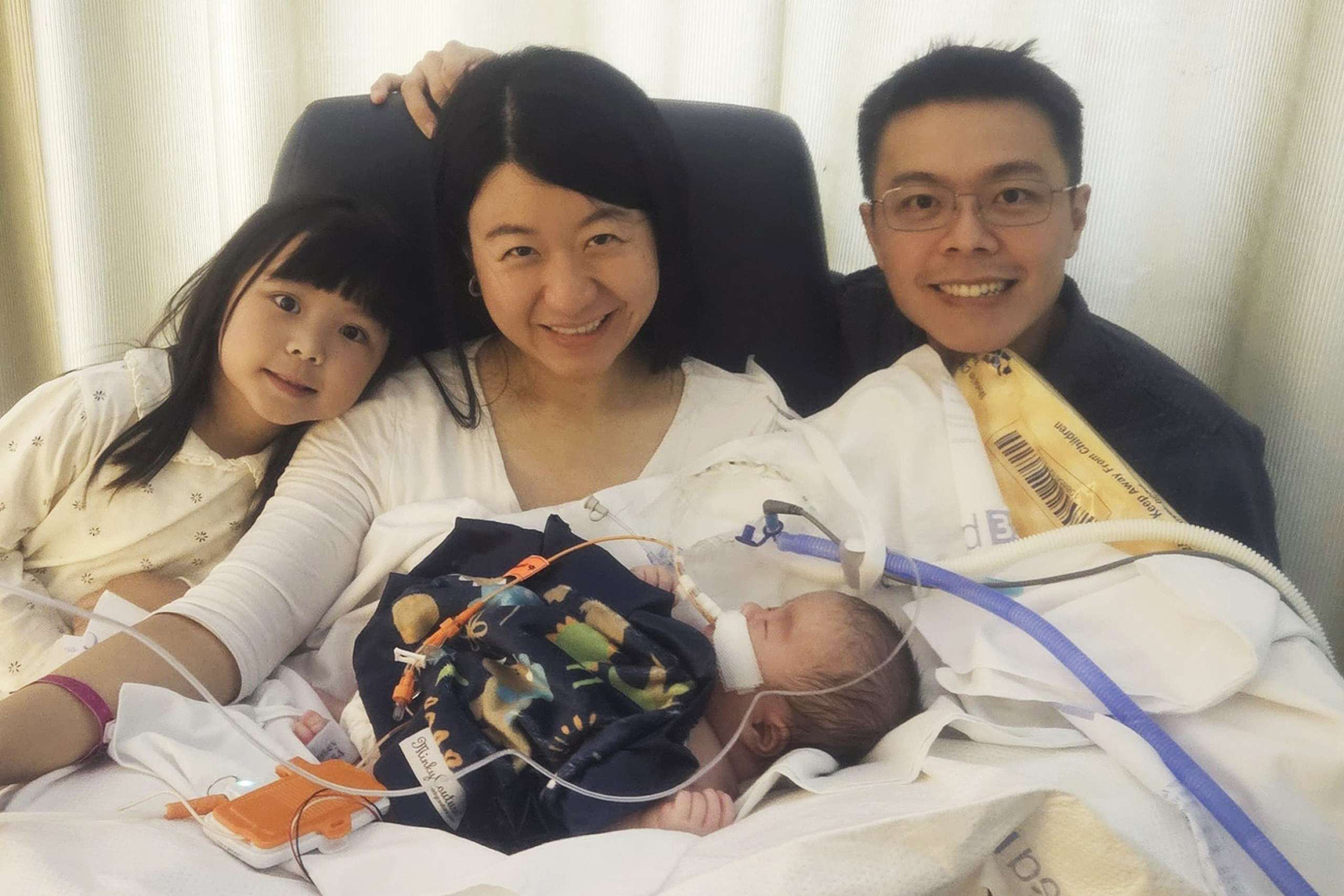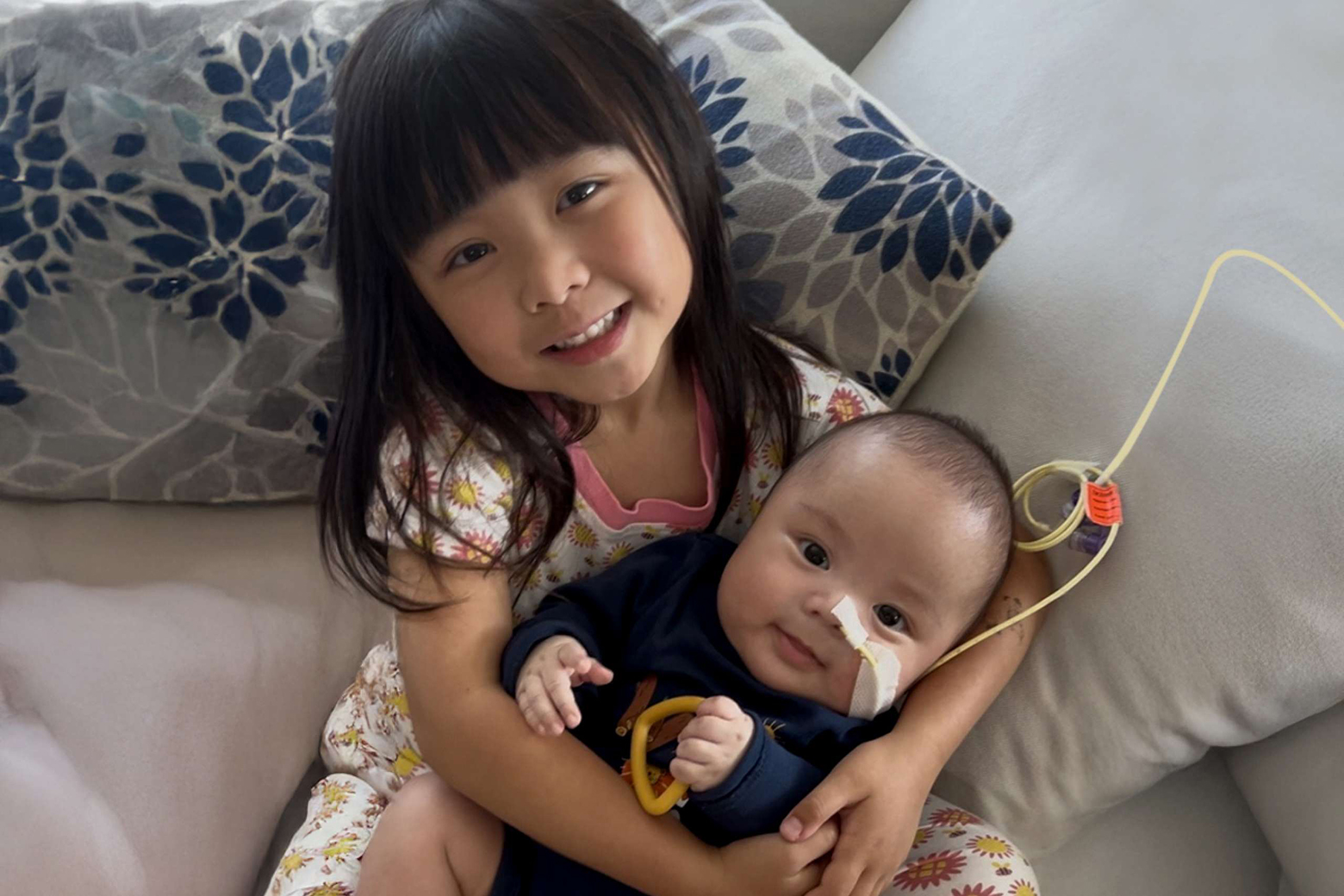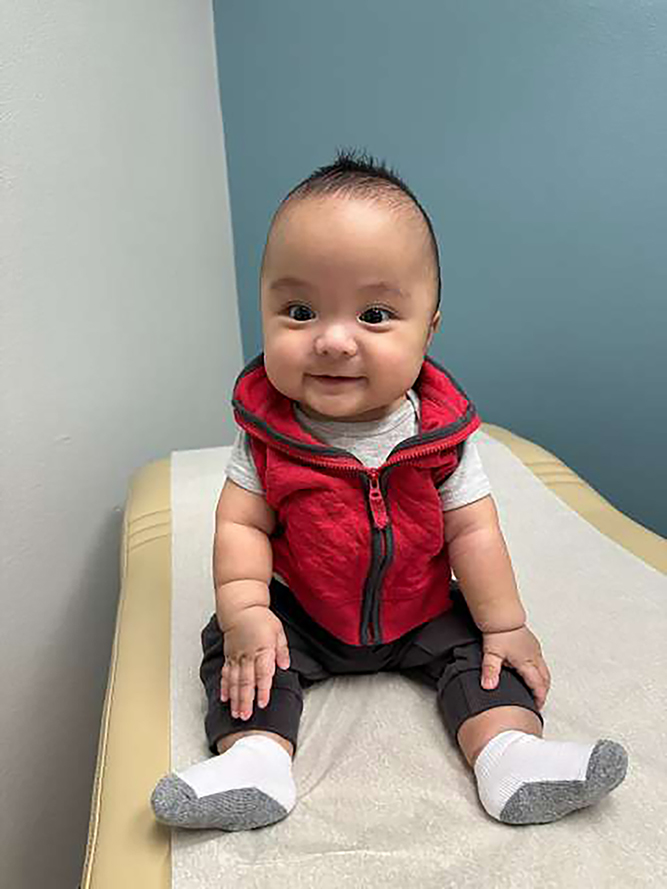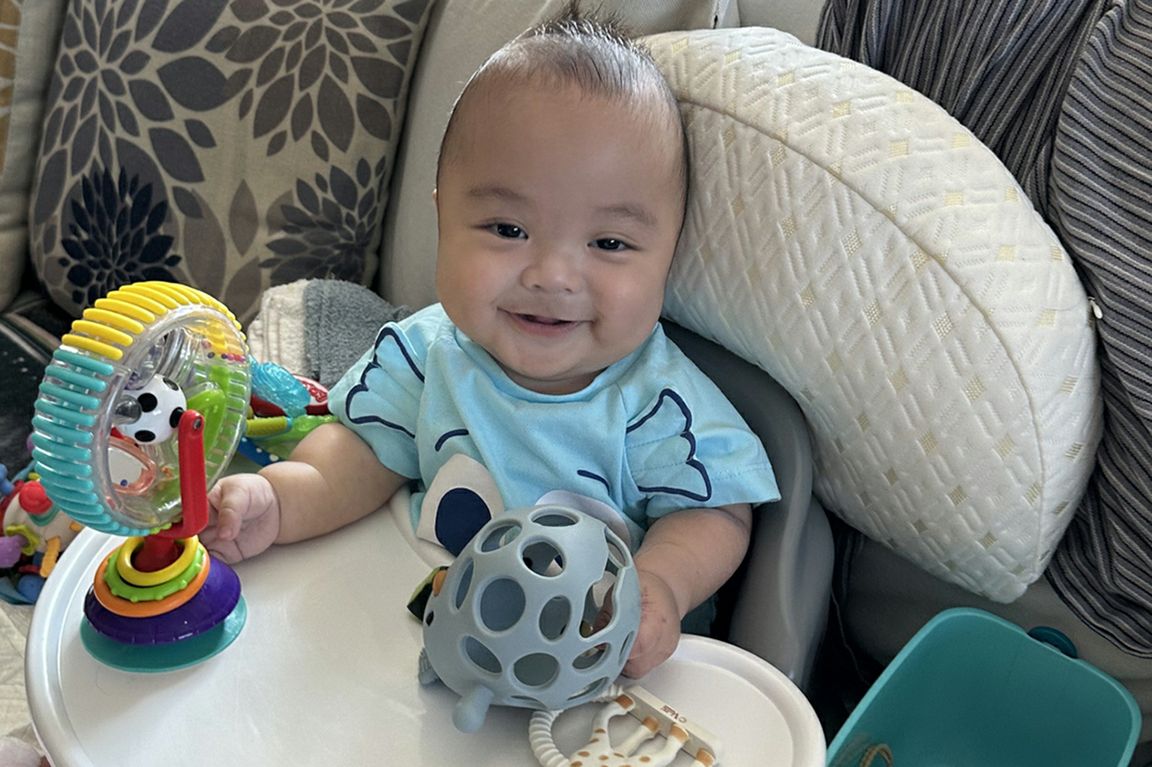Before Francis Saputra was born on Feb. 3, 2025, he’d already been diagnosed with a rare and usually fatal disorder that’s often not identified until birth.
But even more uncommon than his diagnosis was what happened immediately afterward. Within two hours — in what’s likely the first case of starting treatment for this condition so young, according to his doctors at UCLA Health — Francis was able to begin enzyme therapy for the disorder. By his 3-month birthday, he was able to go home.
Francis’ parents, Albert and Liviera Grace Saputra, had already lost one baby to the same genetic disorder, perinatal severe hypophosphatasia, which causes soft bones and teeth due to an inability to mineralize calcium. Cases range from mild to severe and can present prenatally, during the first few months of life, in childhood or in adulthood. The most severe prenatal form, which Francis has, affects only about 1 in 300,000 births and is fatal without immediate treatment.
It isn’t always immediately diagnosed, however, with the symptoms often attributed to other genetic skeletal dysplasia conditions that affect bone growth such as osteogenesis imperfecta (brittle bone disease) or various forms of dwarfism.
“It’s so rare that if you’ve never seen it, you don’t immediately recognize it,” said Dr. Deborah Krakow, assistant dean of genetics and genomics and UCLA Health’s chief genomic officer, and professor of orthopedic surgery and human genetics at the David Geffen School of Medicine at UCLA.
Testing, monitoring and planning
When the Saputras’ first son was born in 2019 at a local hospital, prenatal ultrasounds showed that his limbs would be shorter than normal. Liviera Grace and Albert expected that he’d have dwarfism. But the baby, John, actually had perinatal severe hypophosphatasia, which wasn’t diagnosed until after he was born. He lived just 33 hours.
Both parents subsequently underwent genetic testing and found that they were recessive carriers for the disorder.
When Liviera Grace became pregnant again, she was monitored by a fetal maternal specialist. This time, though, all of the developing fetus’ measurements were considered normal; daughter Gianna was born in April of 2020 with no signs of the disorder.

Courtesy of the Saputra family
Newborn Francis Saputra is welcomed by his family, from left, sister Gianna, mom Liviera Grace and dad Albert.
During Liviera Grace’s pregnancy with Francis, however, ultrasounds revealed that he had shortened limbs, and that the condition was becoming more pronounced as he grew. Having learned of Krakow’s expertise after the birth of her first son, she immediately booked an appointment.
By this point, Liviera Grace was about 26 weeks pregnant.
After reviewing the ultrasounds, Krakow diagnosed perinatal severe hypophosphatasia. Liviera Grace’s baby would need to begin enzyme replacement therapy as quickly as possible after birth to maximize his chance of survival.
“I told her, ‘There’s now treatment available, but it’s still a very arduous course,’” Krakow said. “This was one of those cases where there were no promises.”
Although the treatment has been available for the last several years, time is of the essence in a case like this: Babies born with perinatal severe hypophosphatasia lose critical time when they’re not diagnosed until after they’re born. Moreover, for medical professionals who aren’t familiar with the disease, it’s often a scramble to identify specialists and determine the correct diagnosis.
The enzyme that Francis was missing, alkaline phosphatase, is critical for making hydroxyapatite crystals, the form of calcium necessary for bone growth and durability, Krakow said. Without the enzyme, “you can’t make these tiny crystals,” she explained, “and the bone cannot mineralize calcium.”
The result is profound skeletal weakness, including chest deformities that impede breathing. “When you have these very weakened ribs laying on top of the lungs, the ribs are just like noodles,” Krakow said. “The lungs try to expand but can’t.”
A team approach
As Liviera Grace’s due date approached, Krakow continued to see her every few weeks. Meanwhile, she focused on coordinating the care team and resources that would be needed immediately after the birth.
The first step was obtaining the enzyme therapy, which is usually given on an outpatient basis, for in-hospital use. “Our nurse practitioner, Lauren Mackenzie Mason, was critical in getting the treatment,” Krakow said.
The UCLA Neonatal Intensive Care Unit (NICU) also had to plan in advance for the specific respiratory support that Francis would need, she noted, given that Francis’ condition would make ventilation more difficult. They also obtained a special mattress that would best protect his fragile bones until the medication began to do its work.
Dr. Kiran Kavipurapu, an obstetrician and gynecologist whose expertise includes high-risk pregnancies, agreed to take on Liviera Grace as a patient to deliver the baby by cesarean section, with Krakow there as well to begin caring for the baby as quickly as possible.
With the team assembled, the medication procured and the NICU prepped, UCLA Health was ready for Francis’ arrival.
Francis’ first months
On delivery day, Liviera Grace and Albert arrived at Ronald Reagan UCLA Medical Center early. “The (operating room) was already full of people — nurses, respiratory therapists, anesthesiologists and NICU staff, all standing by, not just ready, but present, with love,” she recalled.
As soon as Francis was stabilized and had undergone baseline testing, he received his first enzyme therapy shot. Krakow said Francis is likely the youngest patient to date to receive treatment for the condition. “I’ve never treated anyone at two hours of age; I don’t think anyone’s ever treated someone at two hours of age,” she said.
At first, he was so fragile that his parents weren’t allowed to hold him. He required a ventilator to breathe and a nasogastric tube for feeding.
When Francis was 1 week old, his parents were able to hold him for the first time, but only while he rested on top of his tiny, specialized mattress to support his still-weak bones.

Courtesy of the Saputra family
Gianna Saputra enjoys spending time with her brother.
As Francis continued the thrice-weekly enzyme shots, however, he quickly gained strength.
By the time he was a month old, his bones were strong enough that his parents could hold him without needing to cradle him on the mattress. “The first true cuddle felt like a miracle,” Liviera Grace said.
By 2 months, he was able to breathe on his own and was removed from the ventilator, but he still needed to be weaned off of the various pain medications, including morphine, he was receiving. Through that period, all UCLA Health neonatologists collaborated to develop a pathway to accomplish the complicated care.
Meanwhile, Liviera Grace was pumping so that Francis could receive breast milk in addition to the nutrition he received via his tube.
During daily trips from their Alhambra home to visit Francis — a drive that often took up to two hours each way — Liviera Grace and Albert frequently brought their young daughter. Members of the UCLA Health Child Life program, which provides support for pediatric patients and their siblings, “welcomed her curiosity,” Liviera Grace said. The Child Life Specialists also visited Francis in the NICU, where they sang to him and read him books.
“Every step of the way,” she said, “the UCLA team stood beside us.” Francis’ primary nurses in the NICU — Josie Sunga, Liz Blackwood, Katie Haugh and Ivonne Alonzo – “didn’t just care for Francis, they cherished him.”
Krakow also visited Francis frequently in the NICU, Liviera Grace said, stopping by just to say hi even when she was there to see other patients.
On May 3 — exactly three months after he was born — Francis was stable enough to be discharged.
An ‘incredible’ transformation
Francis’ parents now administer his enzyme shots at home and continue to supplement his tube feeding with bottles. He swallows slowly, Liviera Grace said, due to his low muscle tone, but receives both occupational and physical therapy to help with feeding and other aspects of development.

Courtesy of the Saputra family
Francis Saputra recently had his nasogastric tube removed.
Other than his tube, however, “we treat him like a normal baby,” she said. “His transformation is nothing short of incredible. His bones are stronger and his X-rays have improved significantly,” she said. “Every week, we see changes — he’s more alert, stronger and more active.”
So far, Francis has had only slight delays in reaching developmental milestones, she said, adding that he recently began rolling over at 5 months.
On Aug. 11, he had a surgical procedure to replace his nasogastric tube with a gastric tube, eliminating the tube in his nose (which can be uncomfortable) and providing nutrition directly into his stomach. As his feeding therapy continues, it’s expected that he’ll eventually be able to eat on his own.
Francis also will continue to see UCLA Health specialists including a pediatric gastroenterologist to monitor his feeding, a nephrologist who will watch for calcification in the kidneys (a potential side effect of the enzyme therapy), and an endocrinologist to help monitor his growth.
He’ll also be seen by Krakow at UCLA’s Skeletal Dysplasia Clinic every three months, later tapering down to every six months, and will continue to need the enzyme shots for the rest of his life.
In the meantime, Krakow calls the family every Friday after work just to check on Francis.
“He’s been remarkable,” Krakow said. “It’s shocking how much better he is. I believe he’s going to be this lovely, normal child — I’m excited to see him just be a little boy.”
